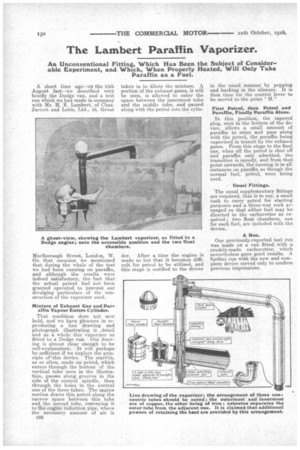The Lambert Paraffin Vaporizer.
Page 4

If you've noticed an error in this article please click here to report it so we can fix it.
An Unconventional Fitting, Which Has Been the Subject of Considerable Experiment, and Which, When Properly Heated, Will Only Take Paraffin as a Fuel.
A short time ago—on the 10th August last—we described very briefly the Dodge van, and a test run which we had made in company with Mr. H. E. Lambert, of Chas. Jarrott and Letts, Ltd., 45, Great Marlborough Street, London, W. On that occasion we mentioned that during the whole of the test we had been running on paraffin, and although the results were indeed satisfactory, the fact that the actual patent had not been granted operated to prevent our divulging particulars of the construction of the vaporizer used.
Mixture of Exhaust Gas and Par... af fin Vapour Enters Cylinder.
That condition does not now hold, and we have pleasure in reproducing a line drawing and photograph illustrating in .detail and as a whole this vaporizer as fitted to a Dodge van. Our drawing is almost clear enough to be self-explanatory. It will perhaps be sufficient if we explain the principle of' this device. The starts, as so often, made on petrol, which enters through the bottom of the vertical tube seen in the illustration, passes along grooves in the side of the central spindle, then through the holes in the central one of the three tubes. The engine suction draws this petrol along the narrow space between this tube and the second tube, conveying it to the engine induction pipe, where the necessary amount of air is
c22 taken in to dilute the mixture. A portion of the exhaust gases, it will be seen, is allowed to enter the space between the innermost tube and the middle tube, and passed along with the petrol into the cylin der. After a time the engine is made so hot that it becomes difficult for petrol to be utilized, and this stage is notified to the driver in the usual manner by popping and barking in the silencer. It is then time for the control lever to be moved to the point "M."
First Petrol, then Petrol and Paraffin, Finally Paraffin Alone, In this position, the tapered plug, seen in the bottom of the'device, allows a, small amount of paraffin to enter and pass along with the petrol, the paraffin being vaporized in transit by the exhaust gases. From this stage to the final one, when all the petrol is shut off and paraffin only admitted, the transition is speedy, and from that point onwards, the running is in all instances on paraffin as though the normal fuel, petrol, were being used.
Usual Fittings.
The usual supplementary fittings are required, that is to say, a small tank to carry petrol for starting purposes and a three-way cock arranged so that either fuel may be directed to the carburetter as required; two float chambers, one for each fuel, are included with the device.
A Ran.
Our previously-reported test run was made on a van fitted with a crudely-made carburetter, which nevertheless gave good results. A further run with the new and complete device served only to confirm previous impressions.
























